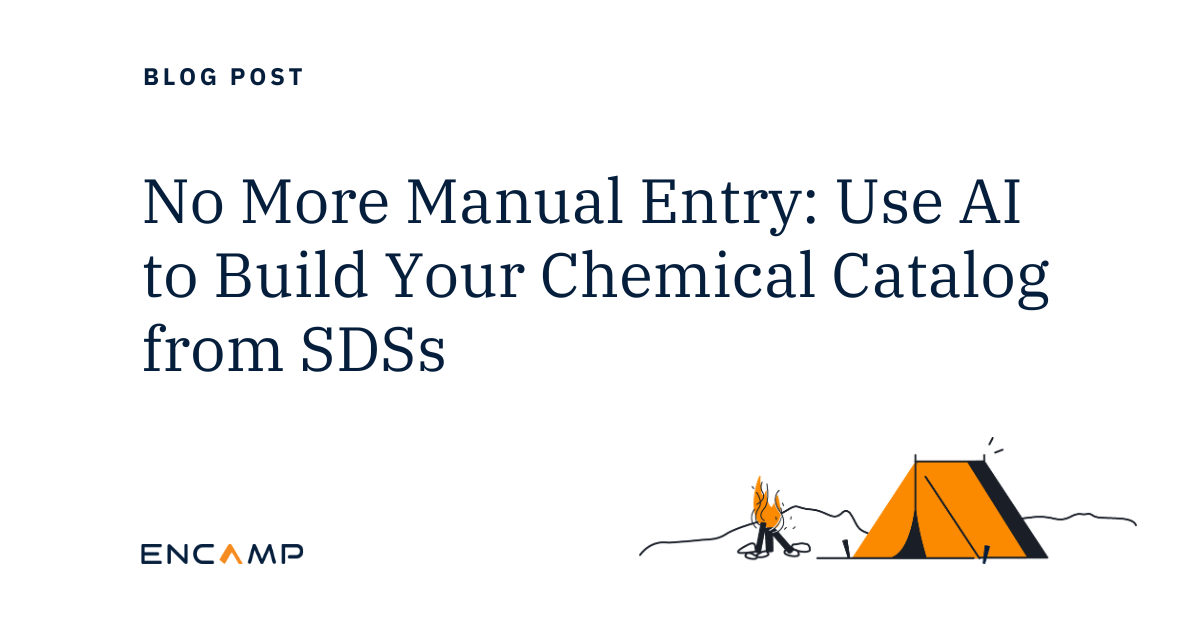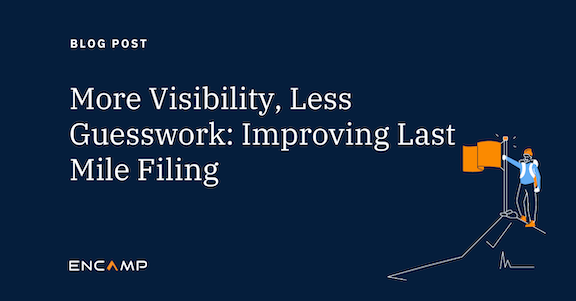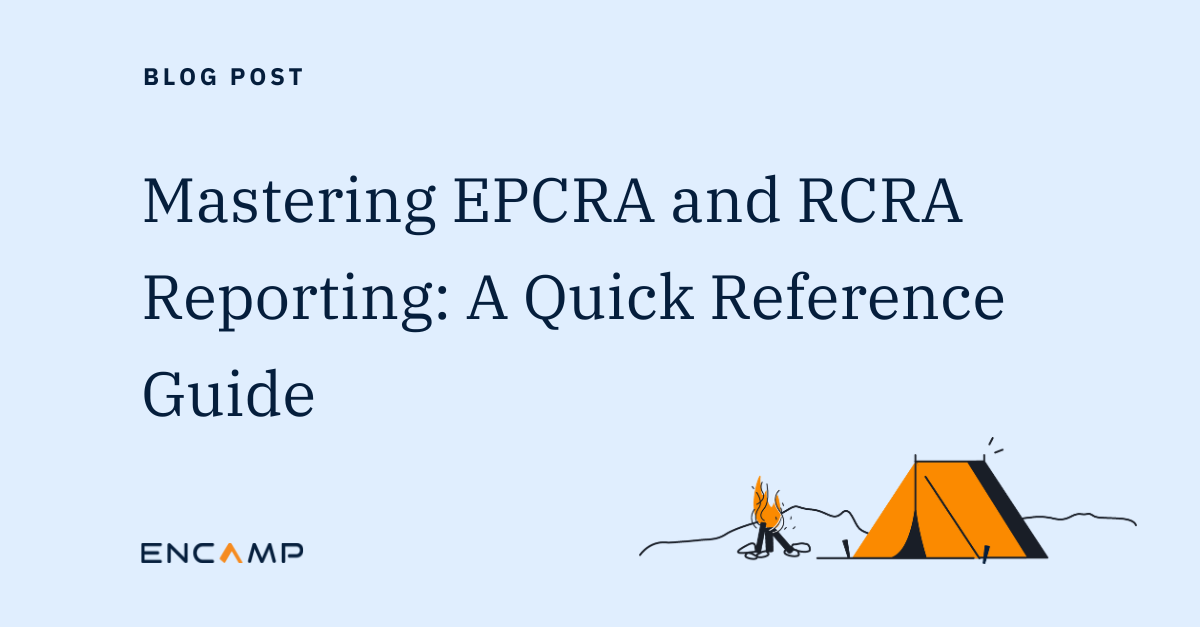For EHS leaders facing constant changes in chemical inventories and regulatory requirements, collecting EHS data for Tier II reporting on a continual basis promotes informed decision making.
To make the kinds of environmental compliance decisions that prevent non-compliance violations, EHS leaders must have clear, accurate, up to date data readily available at all times.
Yet even the most seasoned EHS managers and professionals say collecting facility data for Tier II reports can be exhausting. Decentralized systems, spreadsheets, and a basic lack of time and structure often make the process harder than it should be. But there’s are better ways to get ahead of data collection for Tier II reporting.
Continuous Tier II Data Collection: Best Practices and Takeaways
In the first of a 3-part March to March virtual event series from Encamp, we discussed how to improve the data collection process for Tier II by rethinking it. To start, here are three best practices to consider:
-
- Make time to collect and validate compliance data regularly throughout the year. When Tier II data isn’t available or becomes outdated, it’s hard to fill the cracks.
- Standardize data collection processes to make them repeatable year after year. This drives efficiency — and means no more starting from scratch every reporting year.
- Identify evergreen tasks that compliance stakeholders can complete at any time during the year. Any completed task is a head start to meeting the Tier II reporting deadline.
At Encamp, we can’t say this enough: The secret to ensuring accurate Tier II reporting is to make data collection a continuous priority first.
Make more time to collect and validate compliance data
Depending on chemical inventories, classifications (see the EPA List of Lists), Tier II reporting thresholds and the number of facilities a team must report, one or two months to gather needed compliance information for reporting isn’t always enough. To fully meet EPCRA guidelines, collected EHS data must also be validated and checked for completeness. Where multiple states are involved or when regulations have been updated or changed, EHS operations must additionally verify data applicability for Tier II reporting requirements.
Almost every EHS professional we’ve worked with expresses how tracking down compliance data for a Tier II report is too time-consuming. Sometimes it can literally take weeks or even months, on top of other compliance and sustainability initiatives their team is responsible for. But given the consequences of constant regulatory changes, potential reporting violations, and non-compliance, data collection is a critical task — and EHS leaders must make time for their team to complete it. So instead of starting data collection in January, why not implement a more continuous process from August through December to have data ready to review in January?
Continuous EHS data collection for Tier II promotes informed decision making in response to constant changes in chemical inventories and regulatory requirements.
Standardize and streamline data collection tasks
The lack of time and a structured process for data collection makes Tier II reporting more difficult than it should be. However, rushing compliance reporting can result in invalidated data and missing details that regulators see as red flags. The following safeguards can be invaluable for EHS teams.
More specifically, streamline data collection tasks for distributed facilities — which is especially critical when sites are located in various states. Technology-wise, systems like Encamp let your team digitize and centralize data for product inventories, then standardize the process your facilities and EHS operations use to gather and validate that data. Once a process becomes a standardized function, making it repeatable is an inherent next step to streamlining data collection tasks over an extended period of time, as well as from one facility to the next.
Further, when technology is a single unified platform, it provides a foundation on which to integrate to existing enterprise systems, build data pipelines to individual facilities, and create a core data repository that all EHS data feeds into from these and other sources, such as spreadsheets and even emails. Archiving data this way, along with previous years’ Tier II reports, also gives you a comprehensive, auditable record that regulators appreciate.
Make Tier II reporting strategic across sites
At the facility level, site managers should be able to confirm their facility’s compliance responsibilities by fully determining current product inventory, including thresholds for each reportable chemical. Managers should then reach out to their respective State Emergency Response Commission (SERC) and Local Emergency Planning Committee (LEPC) to make sure the data being collected is in accordance with specific state and local requirements.
For EHS operations, this approach makes Tier II reporting more strategic across sites. More importantly, it provides a safety net to keep details from slipping through the cracks that could result in reporting non-compliance.
Get evergreen tasks out of the way early
Again, the process for EHS data collection is better when collection and validation tasks are scheduled on an extended timeline. It sounds simple, but this is where starting data collection and completing associated tasks in August instead of January-February is a benefit for EHS professionals who are constantly stretched for time. Starting earlier in the year also fits the rule of thumb to have EHS data ready to review by early January for the March 1 Tier II filing date.
From August through December, for instance, focus on evergreen tasks that can be completed at any time: Track changes to reporting requirements at all levels. Confirm emergency contacts at your facilities and update their info as needed. Get in touch with appropriate SERCs, LEPCs and Fire Departments to answer any questions you have, and to build and maintain those relationships. Even review and update things like facility sitemaps and safety data sheets (SDSs).
Come crunch time to start compiling your Tier II reports, evergreen tasks such as these will already be completed.
Data equals knowledge. The earlier you have data, the better position you’ll be in to make informed reporting decisions.
A Checklist to Simplify the Tier II Data Collection Process
In collecting EHS data for Tier II reporting, a checklist is a foundation to standardize and track data collection tasks across facilities. But the new Tier II checklist from Encamp’s regulatory compliance experts goes a step further.
For continuous compliance throughout the year, it lets EHS operations prioritize data collection tasks from August to December while creating a data gathering process that’s streamlined, repeatable and efficient. The intent of this timeframe is to have all data collected the first week of January, while allowing compliance stakeholders to analyze and validate data as information is collected, eliminate gaps (and doubt) in the data itself, and make informed reporting decisions as part of the process. The extended timeframe for data collection further allows more time to compile and submit final Tier II reports before the March 1 due date for EPCRA.
-
- Annual Tier II reports often rely on a variety of data managed by different groups of people: EHS leaders, teams, facility managers, and other stakeholders such as purchasing and shipping departments. Encamp’s centralized platform for direct data entry and tracking reduces the time and effort required to aggregate data across your organization — and do so accurately.
- Along with collecting data for a new reporting year, EHS leaders must often compare it with reporting data from previous years to make sure any and all changes are accounted for. This is where leaders can confirm changes to product inventories, thresholds, regulations, emergency contacts at facilities level and so on. Comparing data lets them determine whether certain new EPCRA notifications must be submitted, or even when Tier II reports don’t need to be filed.
- Environmental laws continually evolve and are regularly amended on both a state and local level, which makes it difficult to collect and track data specific to a compliance program’s requirements. With Encamp, automated threshold calculations for each product can be applied broadly across the organization rather than in a piecemeal fashion during report compilation. Adjusting threshold calculations because of a regulation or permit change is much more manageable when a set of calculations is automated and tracked in a single platform.
Getting started on Tier II data collection
The following tasks for data collection are just one segment of Encamp’s Tier II checklist.
-
- Check the status of state-specific reporting requirements. (Does a facility or certain chemical qualify for Tier II reporting exemptions?)
- Reach out to LEPC or Fire Department contacts.
- Review and update your existing site plan.
- Gather current purchasing information and chemical inventory.
- Compare this year’s data with previous years’ Tier II reports.
- Log in to each applicable state portal to ensure your login information is up to date.
Evergreen tasks that you can do monthly:
-
- Verify any changes in local, state, or federal reporting requirements.
- Review and verify each facility’s listed emergency contact information. If the facility emergency coordinator has changed, you’re required to file an EPCRA 311/302 notification.
- Contact your SERC, LEPC, or Fire Department for any questions prior to the reporting period.
One final, critical note: Sitemaps are important information for first responders to have in the case of an incident, as are SDSs and the info for facility emergency contacts. For every facility that falls under EPCRA requirements, updating this information anytime something changes is a crucial step that states often require for Tier II reports.
Watch the March to March: Data Collection webinar on-demand for more expert insights on successful Tier II reporting.
Transforming the way enterprises stay in compliance
Encamp is on a mission to create a world where good for business can equal good for the environment. We help enterprises transform compliance programs and human processes into a technology-driven system that lays the foundation for accurate and ongoing environmental compliance through a blended method of intelligent high-tech solutions and high-touch expert support.
Madison Martin
As a Compliance Program Manager at Encamp, Madison works closely with customers to help them keep their company’s compliance program running smoothly. Prior to Encamp, she was the Tier II Program Manager and Indiana Emergency Response Commission (IERC) staff member with the Indiana Department of Homeland Security, where she successfully directed the State of Indiana’s Tier II Manager Program for EPCRA compliance.



